|
Dr. Mohammed Mustafa Eltayeb
Specialist environmental studies and research Environment Department Dubai Municipality Email: mmeltayeb@dm.gov.ae |
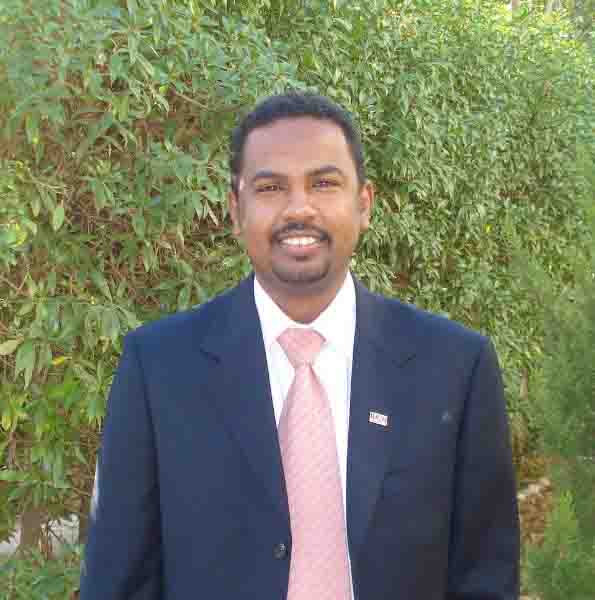
|
ZehraZawawi Raza Shah Zawawi
Natural Protectorates Environment Department Dubai Municipality Email: zzrzawawi@dm.gov.ae |

|
|
Introduction
As Dubai anticipates to host the 13th Meeting of the Conference of the Contracting Parties to the Ramsar Convention on Wetlands in October
2018, the Environment Department at Dubai Municipality has been long celebrating wetlands in the UAE, in particular the Ras Al Khor Wildlife Sanctuary,
which has served as a model example of a wetland for sustainable urban future; incidentally, which is also the main highlight of the 13th COP.
|
Ras al Khor Wildlife Sanctuary – more than just a wetland
Lying at the heart of Dubai City, Ras Al Khor Wildlife Sanctuary (RAKWS) – a wetland of global importance, is an example of an urban
wetland wisely integrated into a city which is sprawling with impressive developments and cityscapes.
|
Management Objectives of Ras Al Khor Wildlife Sanctuary
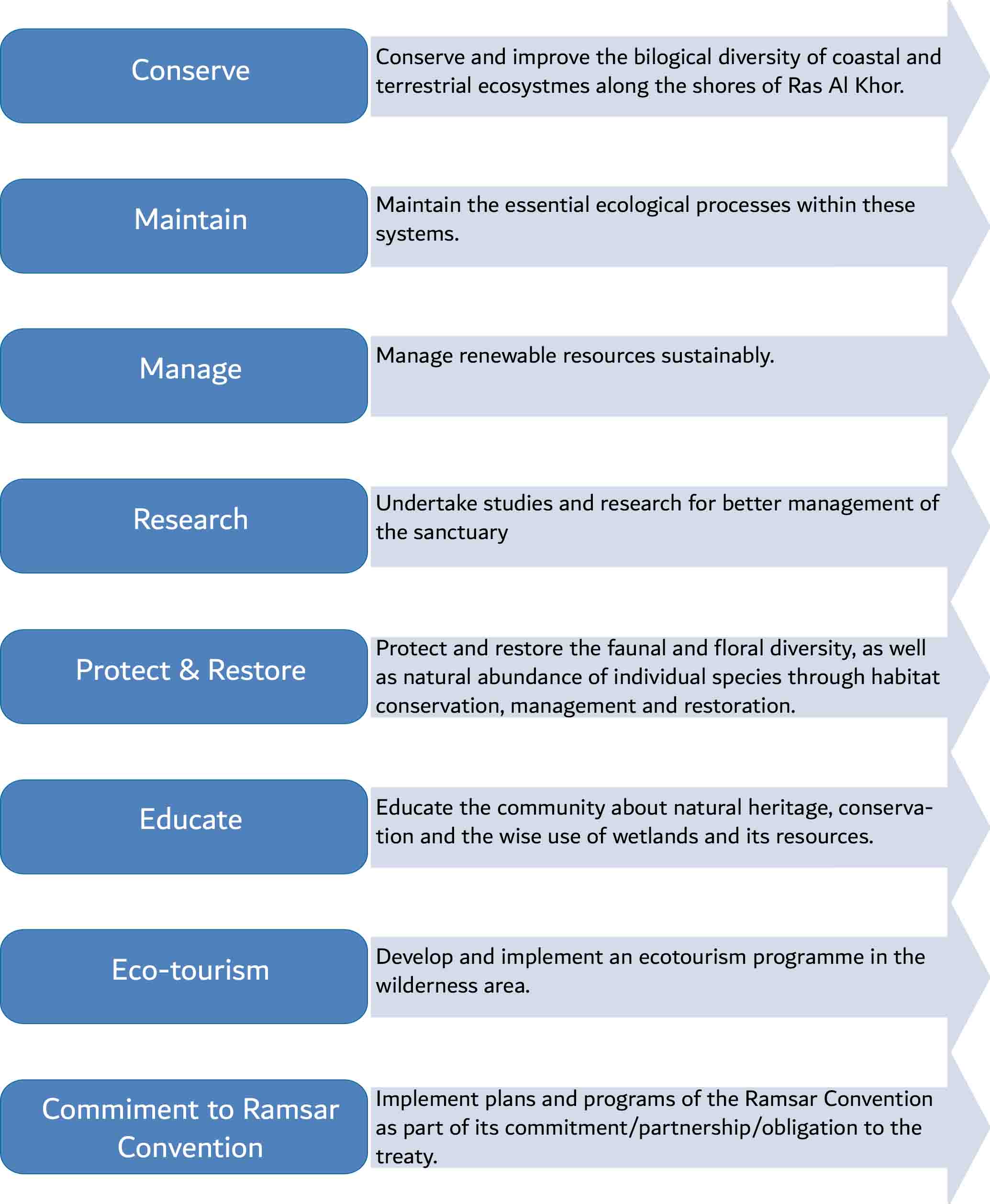
Environmental Laws and Decrees
Existing Federal and Local Laws govern the protection and conservation of Ras Al Khor Wildlife Sanctuary. Some of the Federal Laws include, No.9 of 1983 (ban on wildlife hunting, gathering and destruction), No. 23 of 1999 (Exploitation, Protection and Development of living aquatic resources in the waters of UAE and No. 24 of 1999 (Protection and Development of the Environment).At the Emirate level, among the relevant laws include: Local Order No.11 of 2003 (Establishment of Protected Areas in the Emirate of Dubai), Local Order No. 61 of 1991 (Environmental Protection Regulations in the Emirate of Dubai) and Local Order No. 2 of 1998 (Declaration of Wildlife Sanctuaries in the Emirate of Dubai.)
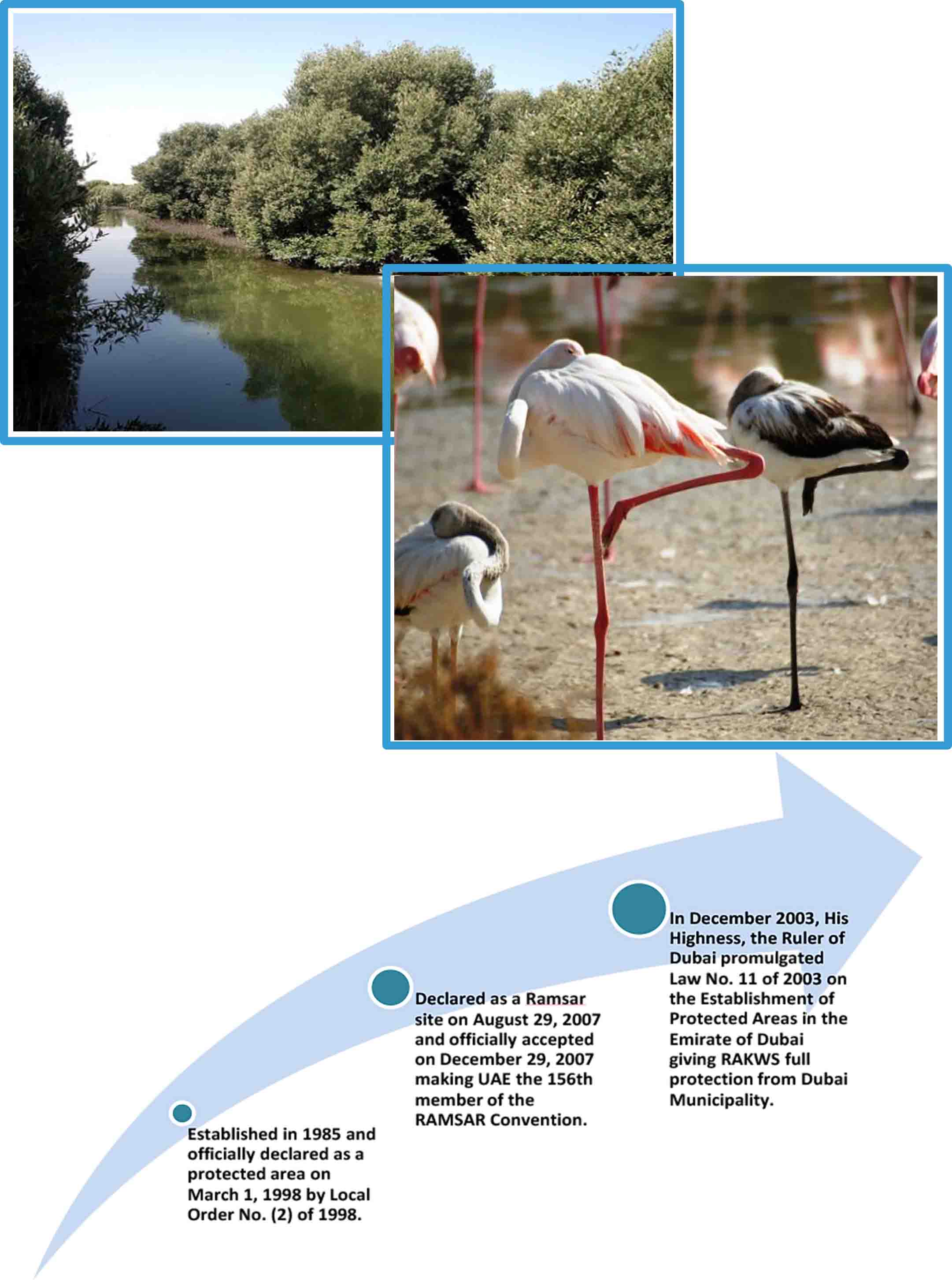
Local Order No. 11 of 2003 specifies:
“Any work, acts, activities or procedures which may destroy or damage wildlife, marine flora and fauna, and effect the aesthetic standard in protected areas,
shall be prohibited; particularly the following:
- Hunting, transporting, killing or disturbing marine or other wildlife; or undertake any acts which lead to their destruction.
- Hunting, removal or transporting of any creatures or organic materials such as mollusks, coral reefs, rocks or soil for any purpose.
- Destroying or transporting plants from the protected areas.
- Damaging or disfiguring geological or geographical formations of areas considered to be the habitat of animal or plant species or their proliferation.
- Introducing non-indigenous species to the protected areas.
- Polluting the soil, water or air of the protected area by any means.
- Constructing buildings, structures, roads using motorized vehicles or practicing any agriculture,
- industrial or commercial activities in the protected areas, or practice any activity, acts or works in areas surrounding the conservation area
- unless by a permit from the competent authority in accordance with approved conditions and rules.
Dubai Municipality’s endeavors to protect Ras Al Khor Wildlife Sanctuary
While the sanctuary without doubt is a model of wetland in Dubai, but it is the efforts of the team at Dubai Municipality who determinedly work to protect Ras Al KhorWildlife Sanctuary that gives the sanctuary its deserved attention. Currently, there are numerous projects undertaken by the team of passionate conservation experts, rangers and the management team which ensures the area is monitored daily and conserved in its best form. A few programmes started by DubaiMunicipality that helps to understand more about the wetland environment, and likewise manage its wildlife and resources, are as below:
Biodiversity Surveys
• Bird Monitoring and satellite tagging
Part of the regular surveys that are being conducted is the determination of the monthly population of the avifauna in RAKWS. This includes satellite tagging which is currently carried out in the sanctuary. In 2006, satellite monitoring programme, on instruction from His Highness, the Ruler of Dubai, ad partnership with Environment Agency – Abu Dhabi lead to interesting information on local movement and migration of flamingoes wintering in Ras Al Khor Wildlife Sanctuary.
• Water-Bird Ringing
In order to understand the behavior of the avifaunal migratory species, bird ringing is being conducted in the RAKWS. A ringing project was launched in late 2013 by Natural Resources Conservation Section, Environment Department of Dubai Municipality aiming to tag migratory birds to determine their migratory pathways for better management of its habitats. Hundreds of various water birds were ringed /recaptured at the site during the last period.
• Mangrove Density Survey
The Mangrove Density Survey at RAKWS confirms that the grey mangrove, Avicennia marina is well established, supporting flourishing epifaunal communities bearing fruits, producing seedlings and spreading in the mid to upper intertidal zone of the conservation area. Mangroves at the RAKWS were generally characterized by a dense canopy of green leaves and fruits, and the mangroves’ health status was considered to be good, given the high density of trees, seedlings and saplings, absence of disease and epifaunal abundances recorded in the area.
• Benthic Population Survey
The waders in the RAKWS depends on the faunal benthic population. This survey determines the species and density of the population, which will also describe the food chain in the sanctuary.
• Fish Survey
In order to establish the seasonality of various populations of fish species in the RAKWS area, routine surveys are conducted on a monthly basis. The species are counted, measured and weighed and its biological information is determined.
Habitat Management
Through its habitat management practices, Dubai Municipality aims to benefit more than one species of wildlife at a time with the purpose of maintaining and enhancing the existing habitats so that biodiversity as a whole within the area can thrive successfully. Some of the programmes started by Natural Resources Conservation Section include:
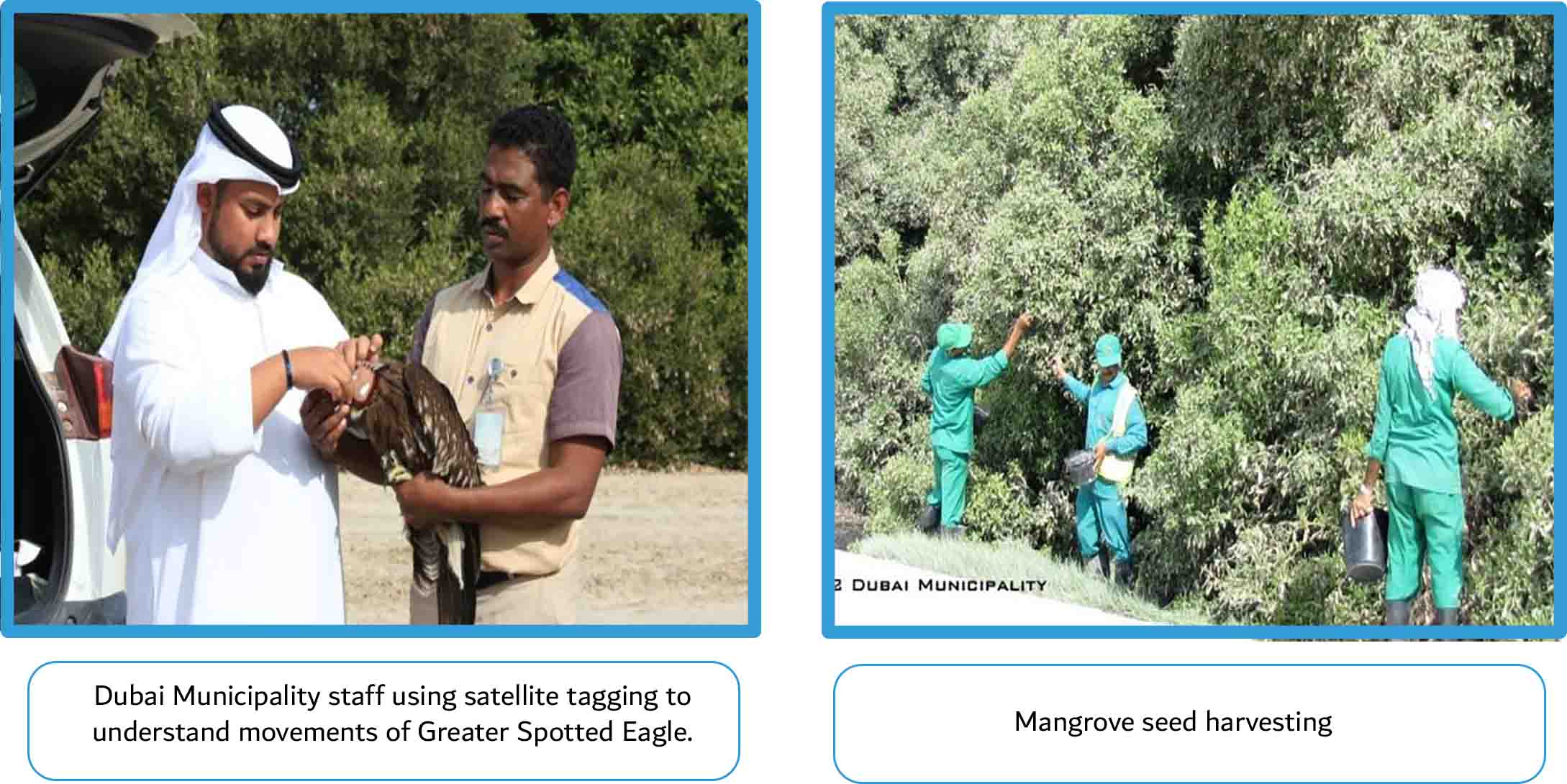
1. Mangrove Management
Since the mangrove planting done in the 1990’s, the mangrove population in the RAKWS has been thriving. In some areas of the sanctuary, mangrove saplings were observed to be growing in adjacent habitats. Constant monitoring, proper waste management and effective law enforcement are among the factors that restored the health of the mangroves. To ensure proper management of the mangroves, collaboration with other stakeholders is continuously being strengthened. Mangrove habitat surveys are being conducted to monitor its condition. Furthermore, private institutions also participate in cleaning the mangrove areas as part of the sanctuary’s awareness program.
2. Water Quality Analysis
The water quality at RAKWS is periodically monitored to understand the ecological dynamics the sanctuary is experiencing at any given time.
The monitoring programme serves the following purposes:
• Indicate the state of health of marine waters.
• Asses compliance with the statutory Water Quality Objectives (WQOs).
• Reveal long-term changes in water quality.
• Provide basis for the planning of pollution control strategies
3. Sediment Analysis
Due to the dynamic developmental activities surrounding the RAKWS, the sanctuary has been a depository of diverse effluents. To determine the level of macromolecules in the sediment of the sanctuary, sediment analyses are conducted. The parameters of the analysis are Chromium, Copper, Lead, Nickel and Zinc.
Ras as Al Khor Wilfe Sanctuary - a learning institute
In addition to the conservation programmes, Ras Al Khor Wildlife Sanctuary is a fortress of education and learning platform for people from all walks of life. In order to connect people with nature and the breathtaking wildlife of Ras Al Khor Wildlife Sanctuary, Dubai Municipality established three bird hides at strategic locations. The bird hides constitute the first step towards a comprehensive visitor education progarmme with bird watching, guided tours and educational talks, celebrations such as World Wetlands Day and World Migratory Bird Day being among the initiatives organized by the Natural Resources Conservation Section for the public to better appreciate the importance of wetlands.
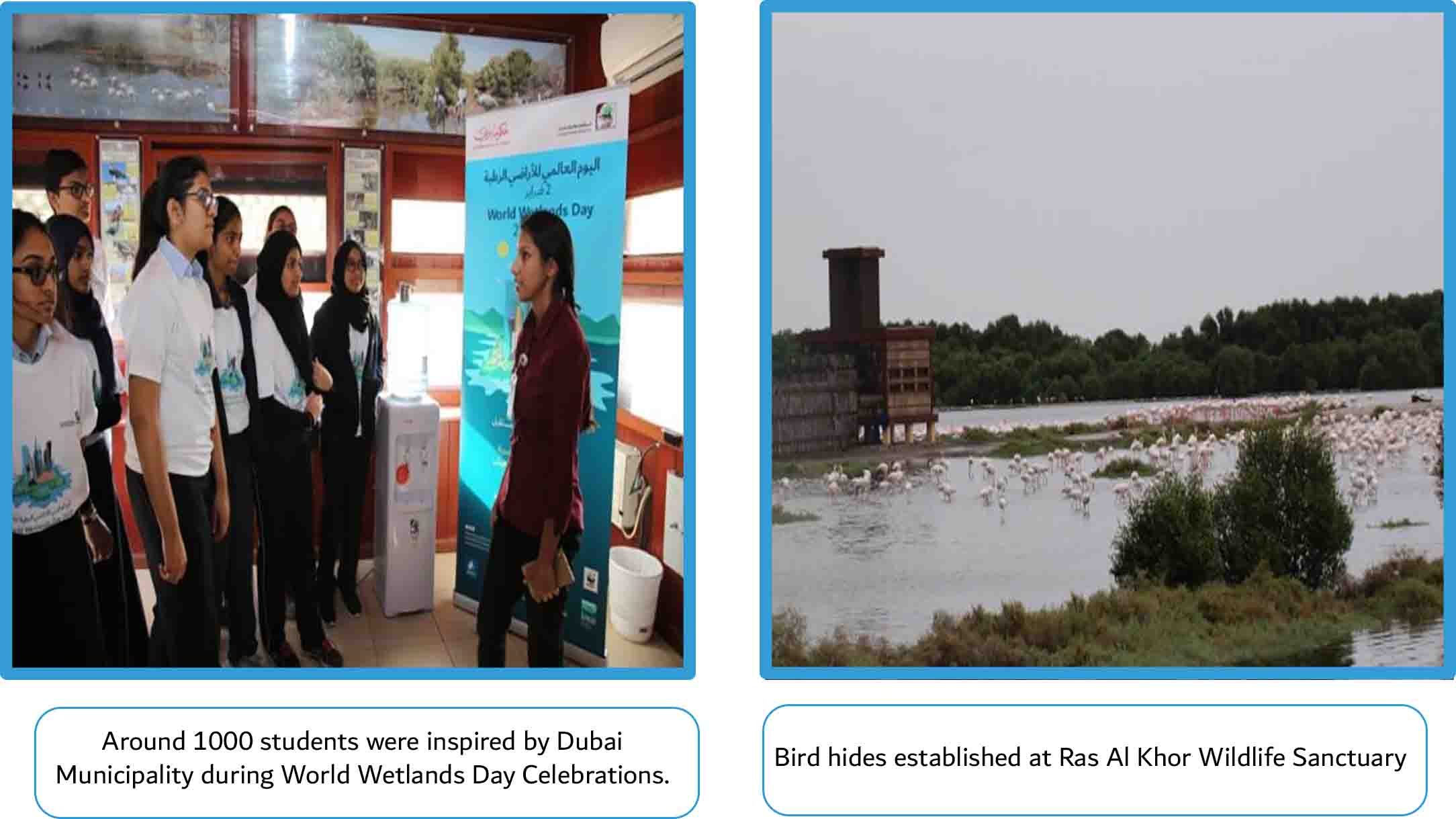
Dubai Wetland Centre– Centre of Excellence in CEPA
One of the projects in the pipeline by Dubai Municipality is the Dubai Wetland Centre which will serve as the Regional Center for Excellence in Communication,
Education and Public Awareness (CEPA) with the goal of promoting awareness of wetland ecosystems and wetland management in the Arab region. The centre aims to
become the hub for wetland experts, researchers, students and tourist alike by engaging them in various activities including educational visits, nature walks,
bird watching and interactive displays. With the establishment of the centre, visitors will get to connect with nature and gain appreciation of the role of wetlands
in maintaining the fragile ecological balance of the coastal areas.
Dubai Municipality constantly strives to protect the sanctuary and has played a vital role in bringing different stakeholders and conservationist together by
organizing workshops and sharing knowledge region wide, as well as at an international level. By setting an example of a best management practices, constant research development,
massive outreach and scope for eco-tourism, Ras Al Khor Wildlife Sanctuary is truly an inspiration for the Middle East and the conservation world.